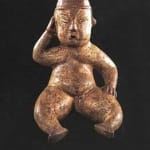Olmecoid Terracotta Sculpture of a Seated Baby, 1000 BCE - 500 CE
Terracotta
11
PF.3879
'The Olmec civilization, which was discovered barely forty years ago, is still not well known. Its name comes from the inhabitants of that region in the 16th century, the Olmeca,...
"The Olmec civilization, which was discovered barely forty years ago, is still not well known. Its name comes from the inhabitants of that region in the 16th century, the Olmeca, the "People-from-the-Land-of-Rubber". Often this civilization is regarded as the mother civilization of Mesoamerica, for this is where the great ceremonial centers, the ball-courts, the sculptured monuments and writing appear for the first time. From about 1300 to 500 BC, this civilization spread out all over Meso-America." The spread of this civilization is seen in this Olmecoid seated baby that is from culturally rich country of Costa Rica. Although it is reminiscent of the Olmec culture, there are visible differences. The nose and mouth are depicted with an individual style all of its own. The forehead does not appear to have cranial deformation, which is common in the Olmec, seated babies. The tummy and posture is not quite as upright as other examples known to be Olmec. Perhaps this seated baby represents the infusion of two great cultures: the Olmec and the Costa Ricans. Like all other cultures across the world, there has always been trade and discovery that leads to the sharing of ideas and artistic styles. Evidently, it appears to have happened here, as well. We are left with admiration for the technical skills, the purely aesthetic emotions felt for this object and with questions to its meaning. When we behold this masterpiece, our eyes are listening.
Literature
V18



